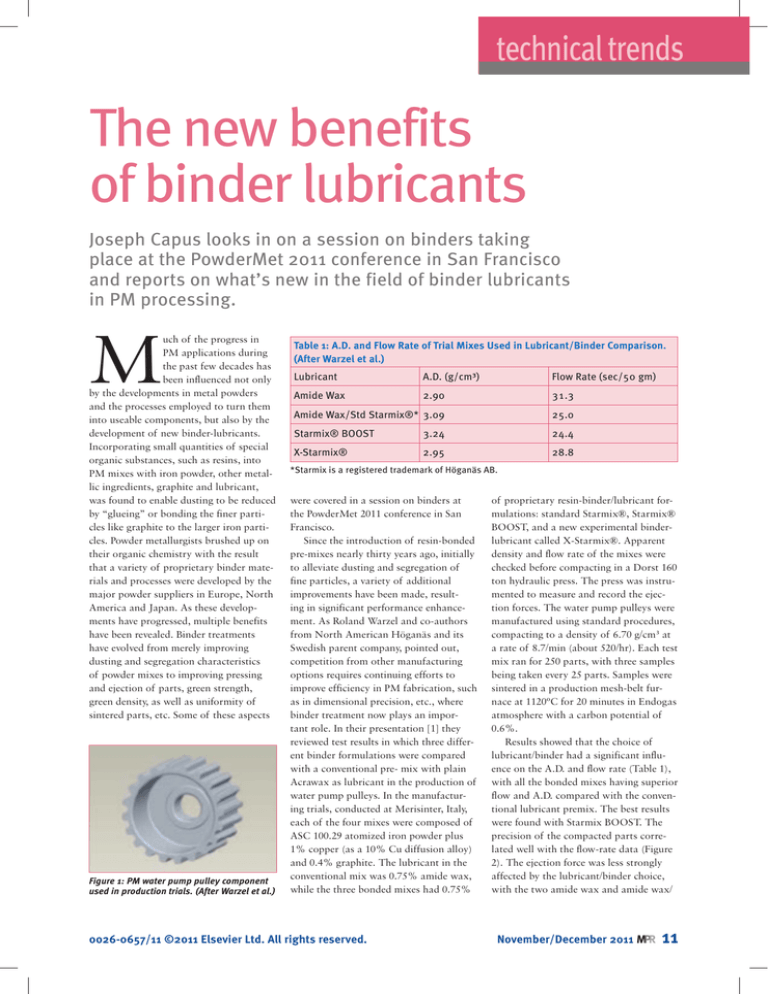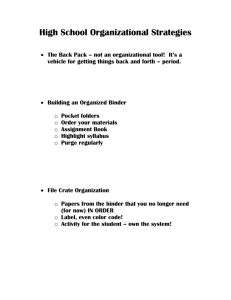
technical trends
The new benefits
of binder lubricants
Joseph Capus looks in on a session on binders taking
place at the PowderMet 2011 conference in San Francisco
and reports on what’s new in the field of binder lubricants
in PM processing.
M
uch of the progress in
PM applications during
the past few decades has
been influenced not only
by the developments in metal powders
and the processes employed to turn them
into useable components, but also by the
development of new binder-lubricants.
Incorporating small quantities of special
organic substances, such as resins, into
PM mixes with iron powder, other metallic ingredients, graphite and lubricant,
was found to enable dusting to be reduced
by “glueing” or bonding the finer particles like graphite to the larger iron particles. Powder metallurgists brushed up on
their organic chemistry with the result
that a variety of proprietary binder materials and processes were developed by the
major powder suppliers in Europe, North
America and Japan. As these developments have progressed, multiple benefits
have been revealed. Binder treatments
have evolved from merely improving
dusting and segregation characteristics
of powder mixes to improving pressing
and ejection of parts, green strength,
green density, as well as uniformity of
sintered parts, etc. Some of these aspects
Figure 1: PM water pump pulley component
used in production trials. (After Warzel et al.)
Table 1: A.D. and Flow Rate of Trial Mixes Used in Lubricant/Binder Comparison.
(After Warzel et al.)
Lubricant
A.D. (g/cm³)
Flow Rate (sec/50 gm)
Amide Wax
2.90
31.3
Amide Wax/Std Starmix®* 3.09
25.0
Starmix® BOOST
3.24
24.4
X-Starmix®
2.95
28.8
*Starmix is a registered trademark of Höganäs AB.
were covered in a session on binders at
the PowderMet 2011 conference in San
Francisco.
Since the introduction of resin-bonded
pre-mixes nearly thirty years ago, initially
to alleviate dusting and segregation of
fine particles, a variety of additional
improvements have been made, resulting in significant performance enhancement. As Roland Warzel and co-authors
from North American Höganäs and its
Swedish parent company, pointed out,
competition from other manufacturing
options requires continuing efforts to
improve efficiency in PM fabrication, such
as in dimensional precision, etc., where
binder treatment now plays an important role. In their presentation [1] they
reviewed test results in which three different binder formulations were compared
with a conventional pre- mix with plain
Acrawax as lubricant in the production of
water pump pulleys. In the manufacturing trials, conducted at Merisinter, Italy,
each of the four mixes were composed of
ASC 100.29 atomized iron powder plus
1% copper (as a 10% Cu diffusion alloy)
and 0.4% graphite. The lubricant in the
conventional mix was 0.75% amide wax,
while the three bonded mixes had 0.75%
0026-0657/11
©2011 Elsevier Ltd. All rights reserved.
of proprietary resin-binder/lubricant formulations: standard Starmix®, Starmix®
BOOST, and a new experimental binderlubricant called X-Starmix®. Apparent
density and flow rate of the mixes were
checked before compacting in a Dorst 160
ton hydraulic press. The press was instrumented to measure and record the ejection forces. The water pump pulleys were
manufactured using standard procedures,
compacting to a density of 6.70 g/cm³ at
a rate of 8.7/min (about 520/hr). Each test
mix ran for 250 parts, with three samples
being taken every 25 parts. Samples were
sintered in a production mesh-belt furnace at 1120ºC for 20 minutes in Endogas
atmosphere with a carbon potential of
0.6%.
Results showed that the choice of
lubricant/binder had a significant influence on the A.D. and flow rate (Table 1),
with all the bonded mixes having superior
flow and A.D. compared with the conventional lubricant premix. The best results
were found with Starmix BOOST. The
precision of the compacted parts correlated well with the flow-rate data (Figure
2). The ejection force was less strongly
affected by the lubricant/binder choice,
with the two amide wax and amide wax/
November/December 2011 MPR 11
Table 2: Properties of ANCORBOND Mixes.
Apparent
Flow
Density
Green
Density
Green
Strength
Green
Expansion
Strip
Slide
Sintered
DC
Density
TRS
Apparent
Hardness
Material
(g/cm3)
(secs) (g/cm3)
(MPa)
(%)
(MPa)
(MPa) (g/cm3)
(%)
Premix
3.06
35.8
7.21
15.4
0.15
34.2
18.9
7.23
0.06 961
44
ANCORBOND
3.21
27.6
7.20
20.0
0.15
28.8
15.1
7.16
0.06 961
44
ANCORMAX200
3.33
25.5
7.34
26.3
0.11
29.2
17.7
7.35
0.08 1023 46
ANCORMAX450
3.28
26.2
7.47
33.9
0.22
22.8
22.8
7.49
0.11 1100 41
(MPa) (HRA)
Note: Ancormax450 mix has 0.40 w/o graphite to lower PFDTRS
binder mixes showing higher values than
Starmix BOOST and X-Starmix. The
part temperature on ejection followed a
similar correlation, with the X-Starmix
results running an average 10ºC lower
than the amide-wax-based mixes.
Dimensional measurements of the pulleys
after sintering confirmed the influence
of lubricant type on the precision of the
parts. Both the tooth height and run-out
measurements (Figure 3) showed a direct
correlation with the A.D. and flow data
for the powder mixes. Run-out was significantly reduced for the bonded mixes,
with the best performance obtained with
the Starmix BOOST.
Green strength
improvements
A similar comparison of different binder
systems was presented by Chris Schade
and colleagues of Hoeganaes Corp[2].
They drew similar conclusions and
noted that the initially perceived benefits
of reduced segregation and dusting,
together with improved die fill, were
expanded into higher green strength and
other advantages. The authors made a
comparison of alternative approaches
to the suppression of dusting and segregation using a mix composition based
on FN-0205 (iron + 2% nickel + 0.6%
graphite). In a laboratory study of compaction and sintering they compared the
performance of various binder/lubricant
combinations: oils, epoxies, and polymers, as well as Hoeganaes own proprietary binder/lubricant systems. While
they found that the use of oil, epoxy or
polymer additives were generally quite
effective in reducing dusting, other factors such as lubricity were rather variable. The proprietary ANCORBOND®
binder material “was designed primarily
12 MPR November/December 2011
Figure 2: Weight scatter (measured as one standard deviation) of compacted parts. (After
Warzel et al.)
Figure 3: Average run-out measurements for sintered pulleys. (After Warzel et al.)
metal-powder.net
paction (e,g, ANCORDENSE™450)
led to additional increases in sintered
density and strength (Table 2), as well as
improvements in green strength and ejection characteristics.
Reduced die-wear
Figure 4: Cross-section diagram of cylindrical part evaluated in die-wear tests. (After Hanejko
et al.)
to [enhance] flow and die fill while
simultaneously giving reduced dusting
and reduced part to part variability”.
Initially, the binder was used in addition to the pre-mix lubricant. This
resulted in a limitation of the achievable pressed density due to the lower
pore-free density. The trend to higher
performance PM parts required higher
densities and led to the development of
second-generation ANCORBOND with
a lower combined lubricant and binder
content. This was accomplished by using
“a polymeric binder that had both bond-
ing and lubricating characteristics”. The
second generation ANCORBOND enabled up to 0.1 g/cm³ increased pressed
density compared with conventional
pre-mixes, while maintaining the benefit of increased press rates (of up to
25%), with enhanced powder flow plus
increased material consistency. Details of
the comparison of the second generation
ANCORBOND mix with an Acrawax
mix are given in Table 2. Further developments designed to achieve even higher
densities, such as the heated die system
ANCORMAX™200 and warm com-
Figure 5: Die set used in die-wear tests. (After Hanejko et al.)
14 MPR November/December 2011
Further developments in binders
have resulted in additional, possibly
unexpected, benefits. Francis Hanejko
and colleagues from Hoeganaes
reported in another presentation on
the reduced die-wear achieved in the
compaction of iron-ferrophosphorus
pre-mixes by the use of a new enhanced
binder material. [3]
Sintered Fe-FeP PM compositions
(MPIF Std FY-4500) find applications
in DC magnetic components such
as speed sensors, DC solenoids, DC
flux-return parts, etc., where high
DC permeability and low coercive
force are required. FY-4500 materials
can be produced by pre-mixing highpurity iron powder with fine Fe2P or
Fe3P powders. Unfortunately, these
intermetallic materials have very high
hardness in the region of HV 1000-1050
compared with the particle hardness
of iron powder (about HV 100). As
a consequence, pre-mixes containing
these hard particles can be very
abrasive to the compaction tooling,
causing accentuated die wear. Hanejko
et al. quoted reports that many PM
fabricators using FY-4500 pre-mixes had
to re-face compaction tooling after only
20,000 pieces.
In previously reported tests [4], it
was found that the abrasive effects of
Fe3P particles could be minimised by an
experimental chemical binding system.
Laboratory compaction tests showed
a reduction in strip-and-slide ejection
pressure compared with the binder system
currently in commercial use. Additional
data showed that the mechanical and
magnetic properties were equivalent to
those found with the existing material.
In the San Francisco presentation, results
were shown for die wear characteristics
found with the new advanced binder
system compared with the currentlyused binder in simulated production.
Two 4500 kg FY-4500 test mixes were
prepared: the standard binder-treated
FY-4500 in commercial production,
and an FY-4500 pre-mix made with the
metal-powder.net
advanced binder system. The cylindrical
part (Figure 4) was compacted to
6.95-7.05 g/cm³ in a Dorst TPA 140
mechanical press, at a rate of 700 pieces/
hour. Two identical tool-steel die-sets
(Fig.5) were used and the parts were
compacted at room temperature, running
continuously for 8 hours each day until
about 25,000 parts were made. Samples
were collected every 200 parts. After
compaction, samples were sintered at
1120°C for 20 minutes in 90/10 nitrogen/
hydrogen. Samples were checked for
green and sintered I.D. and O.D., top step
change, and overall surface appearance.
Test results showed no difference in
the mixes regarding A.D., flow rate,
compressibility or green strength. Also,
magnetic testing of sintered toroids
showed no deleterious effect of the
advanced binder system, while other
sintered properties were similar.
Surface temperature measurements
during the compaction trial showed
that the parts made with the enhanced
binder had a maximum temperature
of 60°C at ejection, compared with
68°C for the regular mix. The advanced
binder mix ran for 25,000 parts with no
tool-binding or excessive noise during
compaction or ejection. The commercial
binder mix ran into tool-binding after
about 23,000 pieces and the trial was
stopped. More detailed examination of
the compaction performance revealed
numerous advantages for the new
enhanced binder, “Most significant [of
these] were reduced wear of the core
rod (~75% reduction) and top punch,
[which] manifested itself through
reduced flashing of the parts over the
production run and elimination of die
incidents when the advanced material
was compared to the conventional
product.” Enhanced lubrication of the
new binder system was evidenced by the
lower part ejection temperature. Surface
finish was also improved by the new
binder (Fig.6) due to reduced scoring.
The authors concluded that the bottom line was longer tool life projected for
the new binder system because of reduced
die-wear. “Longer tool life translates into
reduced production cost through reduced
die maintenance and greater ‘up-time’
during production”.
References
[1] R. T. Warzel, S. Luk, M.
Larsson, and P. Knutsson, “The
Capability of a Bonded Mix
to Improve the Precision of a
Powder Metal (PM) Component”,
presented at PowderMet
2011 in San Francisco.
[2] C. Schade, M. Marucci, and
F. Hanejko, “Improved Powder
Performance Through Binder
Treatment of Premixes”,
presented at PowderMet
2011 in San Francisco.
[3] F. Hanejko, W. Tambussi, and J.
Baumgartner, “Evaluation of Die
Wear Characteristics of FY-4500
Materials Utilizing a New Binder
System”, presented at PowderMet
2011 in San Francisco.
[4] F. Hanejko and W. Tambussi,
“Use of Binder-treated Ferrous
PM Pre-mixes for improved
PM Part Production and Part
Density”, presented at PM 2010
World Congress, Florence, Italy.
Things are
getting better!
The most successful
PM companies subscribe
to Metal Powder Report.
Isn’t it time you did?
Think!
www.metal-powder.net
metal-powder.net
November/December 2011 MPR 15


